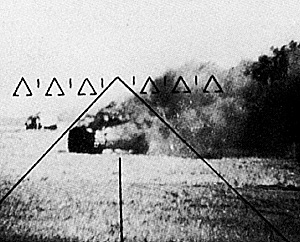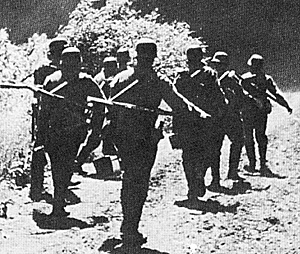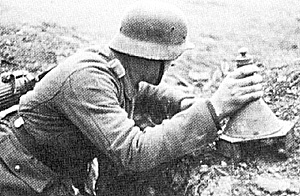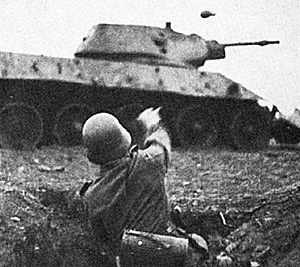 The Germans' offensive doctrine, the "Blitzkrieg" was new and
revolutionary in the early 1940s, but their defensive doctrine was
almost unchanged from the First World War. The German Field Service
Regulation and primary doctrinal document, Truppenfarung, laid out a
principal called "Elastic Defense". This concept was devised in 1916 in
response to the Allies' increasing use of massive preliminary
bombardments. From 1914 it had been the German habit to "hold the
line" by massing as many riflemen as possible in the forward trenches to
mow down the Allies in no-man's-land. When such a defense was treated
to a barrage lasting several days, the end result was a lot of dead Germans.
The Germans' offensive doctrine, the "Blitzkrieg" was new and
revolutionary in the early 1940s, but their defensive doctrine was
almost unchanged from the First World War. The German Field Service
Regulation and primary doctrinal document, Truppenfarung, laid out a
principal called "Elastic Defense". This concept was devised in 1916 in
response to the Allies' increasing use of massive preliminary
bombardments. From 1914 it had been the German habit to "hold the
line" by massing as many riflemen as possible in the forward trenches to
mow down the Allies in no-man's-land. When such a defense was treated
to a barrage lasting several days, the end result was a lot of dead Germans.
To prevent this unnecessary waste of German life, the Germans started putting only token covering forces in the forward trenches and deploying their real strength in depth. When the Allied bombardment came, it would land on mostly empty trenches. The Allied infantry attack would then plod forward, taking casualties from the machine guns and rifles of the covering forces and from short, well timed artillery bombardments.
The Allies would be permitted to penetrate into the depth of the defense, all the time becoming more worn down and disorganized until they reached the Main Line of Resistance - the "HKL". Once the attackers were sufficiently disrupted and their momentum was spent attacking the HKL, the Germans would launch a powerful force - that had been kept well to the rear -against the exhausted Allies, throwing them back from whence they came. The defense was like a rubber band. It stretched as long as force was exerted against it; once the force was spent, it snapped back into place, hurling the intruder out.
 The World War II doctrine's principal concession to the changes
in warfare since 1916 was the development of an antitank defensive
plan that involved using artillery and small arms fire to separate the
infantry from the tanks, then eliminating the tanks by ambushing them
with antitank guns within the defensive zone. Panzers were not
considered to be appropriate antitank weapons and were not to be used
in the defense. Panzers attacked and infantry defended, unless
operational necessity absolutely required otherwise.
The World War II doctrine's principal concession to the changes
in warfare since 1916 was the development of an antitank defensive
plan that involved using artillery and small arms fire to separate the
infantry from the tanks, then eliminating the tanks by ambushing them
with antitank guns within the defensive zone. Panzers were not
considered to be appropriate antitank weapons and were not to be used
in the defense. Panzers attacked and infantry defended, unless
operational necessity absolutely required otherwise.
It is interesting to note that defensive antitank tactics, as laid out in Truppenfuhrung, regarded antitank defense as a secondary consideration and regarded enemy tanks in the attack as mere infantry support weapons - this from the inventors of the Blitzkrieg.
Factors
This concept of Elastic Defense depended upon several factors for its success (and it was a very successful method of trench fighting).
First, it placed a great deal of faith in junior leaders, who under the German principal of Auftragstaktik, were permitted maximum latitude to maneuver within the depth of the defense and take advantage of all opportunities to inflict damage on the attacker.
It also depended upon depth. The defender had to be able to cover his assigned sector with forces sufficient to prevent the enemy from strolling through unchecked, while at the same time being able to hold sufficient forces back to form an HKL and a counterattack reserve. The usual frontage expected of an Infantry Division was around two miles.
It also worked upon the assumption that the antitank guns (Pak or Panzerabwehrkanon) available would be effective against enemy tanks.
As soon as the Germans moved into Russia, these three keystones quickly became undermined. The basic principals of Elastic Defense, which were depth, maneuver, firepower and counterattack, formed the basis of German tactics on the Eastern Front; but the form into which these tactics evolved was not at all what the original authors had envisioned.
The first and most obvious problem faced by the hapless German infantrymen in Russia was the size of the area to be defended. Even if all German Infantry Divisions had been at full strength, and most were lucky to maintain 50 to 75% strength, they would not have been able to hold tidy little two mile fronts with deep, well developed, defensive zones. Frontages of one hundred miles or more for understrength Divisions were not unheard of, and huge gaps were inevitable. The best the Germans could do was to hold the road junctions and key terrain, and try to cover the gaps with observation, mines, machine guns and artillery fire.
In order to make up for the desperate shortage of infantrymen, alarm units were routinely formed. These consisted of whatever troops could be scraped together in the rear echelons; signalmen, MPs, clerks, mechanics, invalids and soldiers on leave who just happened to be passing through. Added to this hodge-podge would be the survivors of destroyed formations, extra infantrymen, mounted cavalry, and best of all for defending large expanses of steppe, extra artillery. The standard Tables of Organization & Equipment for the Wehrmacht bore little resemblance to the ad hoc formations that actually existed on the ground.
The second problem was the effectiveness, or lack thereof, of the German Paks. The standard guns were the 37mm Pak 35/36, which was completely helpless against a T-34 or KV-1, and the 50mm Pak 38, which was better, but still not up to the task. The 75mm Pak 40 was fairly effective, but was never available in sufficient quantities.
The real tank killer was the infamous "88". But there were never enough to meet the needs of the infantry and defend the fatherland against allied bombers, so many Infantry Divisions had to make do without them. When they were available, they were not generally deployed forward to keep the Russians out of the German defenses, but held back to stop tanks within the defensive zone. They were far too vulnerable and valuable to leave in an area that might be under Russian observation.
For one of the smaller caliber Paks to open fire was to invite destruction from the often unscathed Russian tanks, and it was not uncommon for German guns to be crushed flat by the almost invincible Russian monsters. Rather than take advantage of the wide open spaces to establish broad kill zones and destroy the Russian tanks at long range, German Paks had to remain concealed for as long as possible and hope to get a good, close-range shot at the flank or rear. The Paks, if they were lucky, might be able to take out a few tanks before they were silenced, but they usually couldn't be counted on to stop a concerted tank attack.
Until 1943 this left only grenades, mines and molotov cocktails in the hands of extremely brave infantrymen to stop the tanks. In 1943, antitank rocket launchers were introduced that extended the effective range of the tank-killer teams to longer than arms-reach. But these still required considerable nerve to use in battle, as their back-blast betrayed the firer's location, and he was unlikely to be allowed a second shot.
 Fuhrer Intervention
Fuhrer Intervention
The last major factor undermining Elastic Defense was the Fuhrer himself. After the defeats around Moscow, Hitler made it clear that he did not like the idea of yielding ground, even temporarily, to prevent excessive casualties. And he did not have the trust in the Prussian officer elite that the elite had in itself. He wanted to bring the Wehrmacht under tighter personal control.
His first step was to remove officers whom he did not trust, at all levels of command, and to take personal command of the Armed Forces. He then issued a series of directives, finally codified in the Fuhrer Defensive Order of 8 September 1942, where he promulgated his doctrine of "hold to the death". All enemy penetrations were to be met with immediate counterattack by any and all forces available, and ground, no matter how operationally worthless, was not to be sacrificed for any reason. Anyone who was found to be disobeying this directive was to be dealt with severely.
This cut to the very heart of Auftragstaktik. For over a century Prussian higher commanders had issued only broad, "mission oriented" directives, and trusted implicitly in the ability of their subordinates to decide how best to accomplish the mission. Disobedience of orders was usually regarded as inititative. According to a German military aphorism "Mules can be taught to obey, but officers must know when to disobey". German armies, using this principle, and relying on the excellent training and judgment of their junior leaders, had consistently displayed a speed and flexibility envied by all who had to fight them.
The result of Hitler's interference in this system was to undermine this trust between the commander and his subordinate. Subordinates were no longer permitted to give up ground on their own initiative and were, in effect, locked in place. The only movement permitted was an immediate counterattack, and that was compulsory, regardless of how foolhardy it might be. Many commanders fell back upon the cowardly tactic of putting all orders in writing and keeping them on file to prove that they had passed on the proper "fight to the death" orders to their subordinates. This put the entire burden on the front line commander, who often had to make the choice between his men and his career.
The only thing mitigating this situation was that were still plenty of officer's willing to risk the Fuhrer's wrath and do the tactically sensible thing. This meant that the chances of any one officer being made a scapegoat were fairly small -- unless the situation in a sector had attracted Hitler's particular attention.
Even with this however, the end result of Hitler's directives was to make the commanders in the field hesitant and slow to react. They would often wait until situations became desperate before pulling back, rather than trying to make the best of a bad situation by maneuvering at the very start.
Mention should also be made of the effect of the weather on the Elastic Defense. The notorious mud of the Russian spring and fall tended to immobilize the Russians as much as it did the Germans. The real enemy, especially during the winter of 1941/42, was the cold.
Winters
During that first winter, the Germans were caught without sufficient winter clothing to keep from freezing to death. To avoid this fate, the German infantry withdrew to villages where shelter could be found. They turned these into isolated strongpoints and held out as best they could against uncoordinated but savage Russian attacks.
In the following winters, the Germans were far better prepared, and were able to stay in the field against the Russians, rather than hiding in huts. However, they never were able to function in the cold as well as the Russians. For the Germans, winter, which grounded planes, restricted visibility and immobilized machines, was an enemy to be overcome. To the Russians, whose men did not seem to feel the cold, who liked nothing more than to close with the Germans, and whose machines were simpler and less tempermental, the winter was a weapon to be used to its fullest.
Since German defensive operations were constrained by the above factors into rather stereotyped patterns, and since the Russians were notorious for their rigidity, German defensive battles tended to develop in a series of predictable stages. The principal factor that determined whether the situation moved on to the next stage was the success or failure of the Russians in continuing the attack.
The first stage would be the Russian preliminary bombardment. At the beginning of the war, the Russian artillery was rather scattered and ineffective. As the war progressed, the Russians became more adept at its use and would create massive bombardments that rivaled anything the Germans' fathers had faced on the Somme (in intensity, if not in duration).
This would be followed by the first Russian attack echelon. Whenever possible the Russians attacked with a huge mass of both tanks and infantry: the infantrymen running alongside the tanks to defend them from antitank weapons, and the tanks dealing with the machine guns that would otherwise mow down the densely packed infantry. The Russians used this tank/infantry combination whenever the terrain allowed it and the tanks were available.
The German response to the first echelon would be to wait until the Russians got within a few hundred yards and then hit them with a concentrated blast of machine gun, mortar, artillery and rifle fire. In areas that were thinly held, only artillery and mortars might be available. This fire would have very little effect on the tanks but could prove effective in pinning the infantry down, leaving the tanks to continue the attack alone. If the German fire was sufficient to halt the infantry, the Russian tanks might either call off the attack and pull back with the infantry or plunge ahead unsupported.
 While a T-34 is an intimidating opponent for a lone infantryman
with a primitive weapon like a molotov cocktail or antitank mine, the T-34, like all tanks, has one fatal flaw. When they "button up" (ie close
their hatches), they are almost completely blind. An infantryman,
provided he is not suffering from "Panzerangst" (fear of tanks), will
find it a managable task to slip up behind the lumbering beast and either
throw his grenade bundle, antitank grenade, or molotov cocktail or (most
effective) attach his magnetic antitank mine.
While a T-34 is an intimidating opponent for a lone infantryman
with a primitive weapon like a molotov cocktail or antitank mine, the T-34, like all tanks, has one fatal flaw. When they "button up" (ie close
their hatches), they are almost completely blind. An infantryman,
provided he is not suffering from "Panzerangst" (fear of tanks), will
find it a managable task to slip up behind the lumbering beast and either
throw his grenade bundle, antitank grenade, or molotov cocktail or (most
effective) attach his magnetic antitank mine.
When Russian tanks charged ahead without infantry support, they often rampaged for quite some time. But almost all were eventually hunted down and destroyed by cool-headed antitank teams armed with these primitive weapons. Such weapons, of course, could not be used against tanks protected by infantrymen.
However, if the Russian infantry stayed with the tanks and closed with the Germans, this combined arms team was difficult to stop. The combined fire of the tanks and the numerous automatic weapons of the infantry would saturate the objective with fire and make effective close range resistance almost impossible. If the Russians managed to keep their infantry and their tanks together and reach the initial objective, they would usually take that objective.
This would be the signal for the German counterattack. The counterattack force would either be infantry forces in the immediate vicinity or a special local reserve held for just such a purpose. This reserve, which was often mounted on bicycles, would attack immediately, before the Russians had time to reinforce and reorganize, supported by as much covering firepower as was available. Panzers would seldom be seen this early in the battle.
If this counterattack failed, the Russian second echelon would pass through the first and plunge ahead, deep into the German rear. Since there were insufficient troops available to the Germans to deploy multiple lines of resistance, once the initial penetration was made, the situation would rapidly become desperate.
If the Germans had 88s, they would probably deploy them in front of the oncoming Russians, and try to catch them in a long range antitank ambush. If this failed, or there were no 88s on hand, the Germans would deploy whatever reserves were available, including their heterogeneous "alarm units", in the path of the Russian tanks.
Crucial Moment
At this crucial moment, the German commander would have to consider the fact that if his troops were to move, they would have to do so on foot, and if he was going to get his artillery out in one piece, they were going to have to be pulled out by horses. If he decided to ignore his Fuhrer and retreat, he would have to start quickly, or the Russians, who were riding on the backs of tanks, might soon have him cut off.
If the infantry reserves and antitank ambushes failed to stop the Russian attack, the infantry would have done all it could. Only then might the Panzers get involved. They would be held back as a "fire brigade" to move to the site of Russian breakthroughs and try to eliminate them.
If Panzers were in the area, and the infantry commander had decided to stand fast, and the Panzers were successful in wiping out the Russian penetration, then the infantry would be able to mend the damage and await the next attack. The line would be held and the Fuhrer would be pleased.
If the Panzers did not arrive in time or they failed to halt the Russian attack, an infantry formation that had elected to stand fast after being penetrated would be in a very bad situation. Their chance to retreat in good order would have passed, and their only hope would be to try to break out, or to divide up into small groups and try to exfiltrate back through the gaps in the Russian ring. However, if Hitler had taken a personal interest in them and had denied them these options, then all they had to look forward to was death, Siberia, or both.
As the war went on, more and more German infantry formations, in following their Fiihrer's orders, found themselves cut off by massive Russian attacks. Rather than abandon them to their fate, the Germans would try to free them with a counterattack. The Russians then had the luxury of digging in and waiting for the Germans to attack them. Such rescue missions, even when they were successful, cost the Germans heavy casualties in personnel and AFVs that they could ill afford.
Slow Learners, but Learning
The Germans endured for the first few years of the war against the seemingly insurmountable obstacles primarily because the Russians were slow in learning how to use their superior weapons and numbers to good advantage. Nineteen-forty-one and 1942 saw uncountable numbers of examples of battles lost more by Russian stupidity than by German skill. In the early years, Russian attacks were uncoordinated and unsupported, and carried out with a blind obedience to orders, regardless of whether those orders had any application to the situation at hand.
Unfortunately for the Germans, the Russians, though slow to learn, eventually did start catching on. After Stalingrad, the Russians had learned enough to wield their superior numbers and equipment as an effective weapon, and this learning process continued throughout the war. The improvement in Russian operational skill more than kept pace with advances in German weaponry (Panthers, Tigers, Panzerfausts, etc), and after Kursk the Russians were the undisputable masters of the battlefield. The Germans were relegated to reacting to repeated Russian blows, each one better executed than the last.
Man for man, the Russians were never as good as the Germans, but with their endless supply of men and tanks and guns, they were good enough.
The situation, as it existed after Kursk, put the Russians in the enviable position of being able to effect a penetration almost anywhere they wished. If they massed sufficient forces against a German infantry formation, they were almost guaranteed a breakthrough. The German infantry was spread too thin to stop them. The Germans' only hope to contain these breakthroughs were the Panzer "fire brigades". But if the Russians had sufficient forces, they could penetrate in so many places and in such strength, that the Panzers would be overwhelmed.
Even when the Germans were temporarily successful in blunting a Russian thrust, the infantry suffered. The footsoldiers lacked the means to stop the Russians at long range, and had to makeup for this technological inferiority with stubborn courage in close combat. It eventually became their job to do little more than wear the Russians down so the Panzers could finish them off (assuming there were any Panzers to be had). For the German infantryman, to be attacked was, very probably, to be overrun. Whether a battle was won in the end by the Russians or the Germans, the infantry would do a lot of dying.
Germany had sent her footsoldiers into Russia on an impossible mission, armed with inadaquate weapons and an unsuitable doctrine, to cater to the whims of a madman. They did their duty better than anyone had a right to expect, but they were doomed from the start.
Translation of German Terms
Auftragstaktik - Mission Tactics
Panzerabwehrkanon (PAK) - Tank-Defense-Cannon - Antitank Gun
Hauptkampflinie (HKL) - Main-Battle-Line - Main line of resistance
Panzerangst - Tank anxiety, a tendency to panic at the sight of tanks
Truppenfiihrung - Troop-leading - The German Field Service Regulation
Bibliography
Davies, WJ.K. German Army Handbook 1939-1945 . Ian Allen Ltd London 1973.
Garthoff, R. L. Soviet Military Doctrine. R-223, The RAND Corporation, 1953.
Hogg, Ian. Encyclopedia of Infantry Weapons of World War II. Bison Books, 1977.
Messenger, Charles, Trench Fighting 1914-1918. Ballantine Books, 1972.
Myers, David. Unit Organizations of World War II. Z&M Enterprises 1977.
1985 Art of War Symposium: From the Dnepr to the Vistula: Soviet Offensive Operations-November 1943-August 1944. Center for Land Warfare, US Army War College.
Schuler, Col. Emil & Col. Hans-Werner Stirius. Infantrie im Kampf. Wehr und Wissen Publishing Co. Darmstadt 1963.
Wray, Major Timothy A. Standing Fast: German Defensive Doctrine on the Russian Front During World War II Combat Studies Institute Research Survey No. 5. US Army Command and General Staff College, Ft. Leavenworth KS.
Back to Table of Contents: CounterAttack # 3
To CounterAttack List of Issues
To MagWeb Master Magazine List
© Copyright 1991 by Pacific Rim Publishing Company.
This article appears in MagWeb.com (Magazine Web) on the Internet World Wide Web.
Other articles from military history and related magazines are available at http://www.magweb.com